Abstract
The mRNA for cysteine-rich secretory protein-3 (CRISP-3) was originally identified in the mouse salivary gland as an androgen-dependent transcript, and is closely related to CRISP-1 and CRISP-2 which are abundantly expressed in the epididymis and testis respectively. Overlapping phage clones encompassing the entire length of the CRISP-3 gene were isolated from a lambda EMBL3 genomic library and analysed. DNA sequencing revealed that the gene consisted of eight exons ranging between 55 and 740 bp in size, and seven introns. All exon-intron junctions conformed to the GT/AG rule established for eukaryotic genes. The length of the introns was determined by PCR and was found to vary between 1.0 and 3.7 kb, indicating that the gene spans over 20 kb of the mouse genome. Primer extension allowed the mapping of the major transcription initiation site to an adenine located at the appropriate position downstream of a bona fide TATA box, in a region corresponding well to the eukaryotic consensus sequence. Over 800 bp of CRISP-3 promoter region were determined and two regions almost exactly matching the androgen-responsive element consensus RGWACANNNTGTWCY detected. In addition, sequences described in the Drosophila melanogaster Sgs-3 gene as being involved in its salivary gland-specific expression as well as two putative OTF- and GATA-binding elements were also found.
Full text
PDF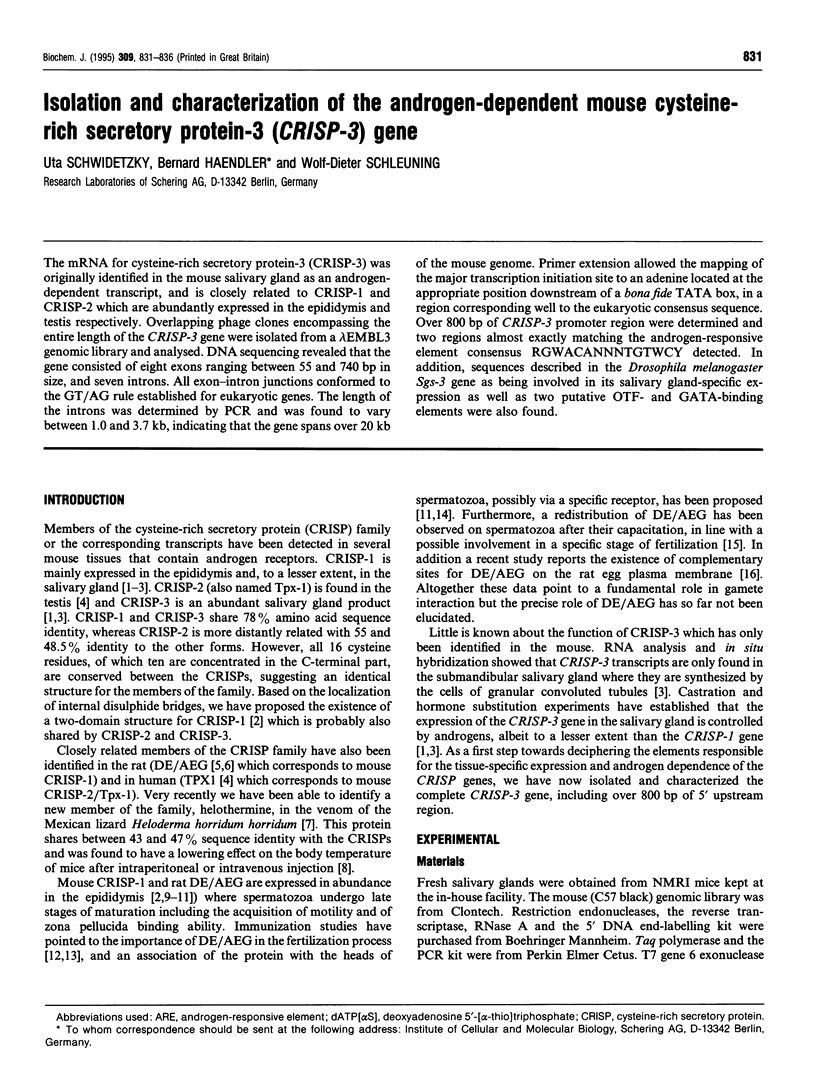
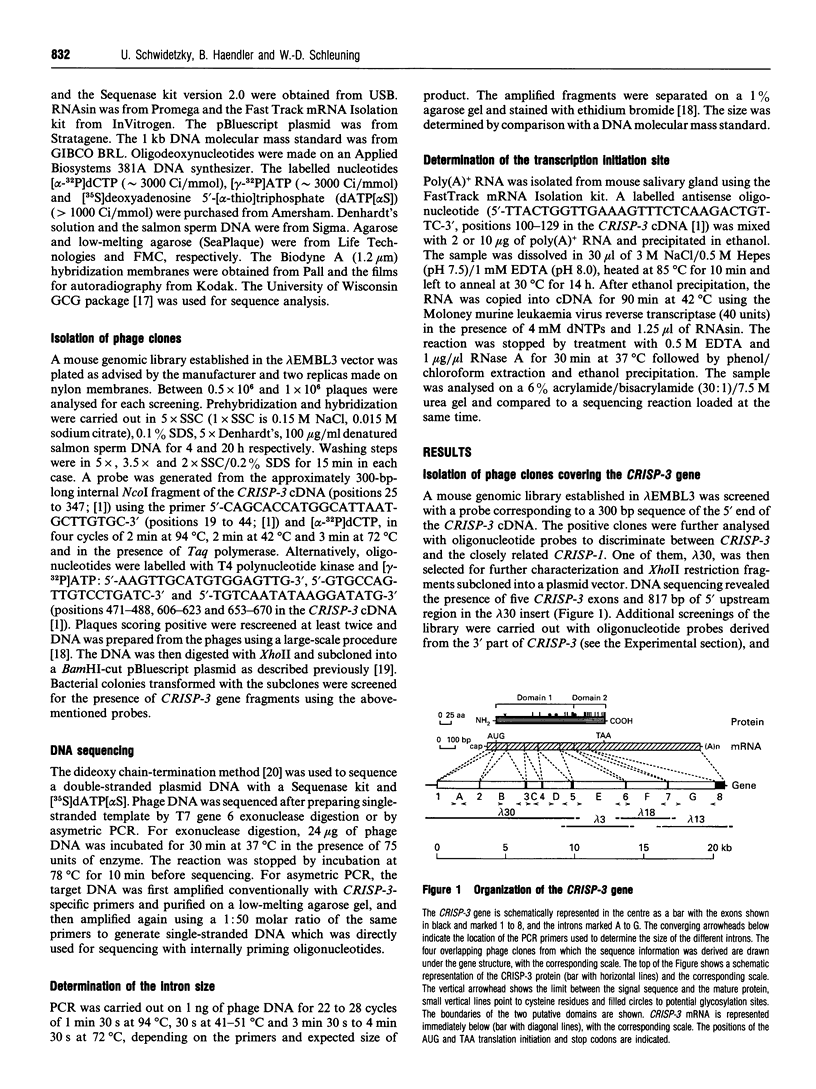
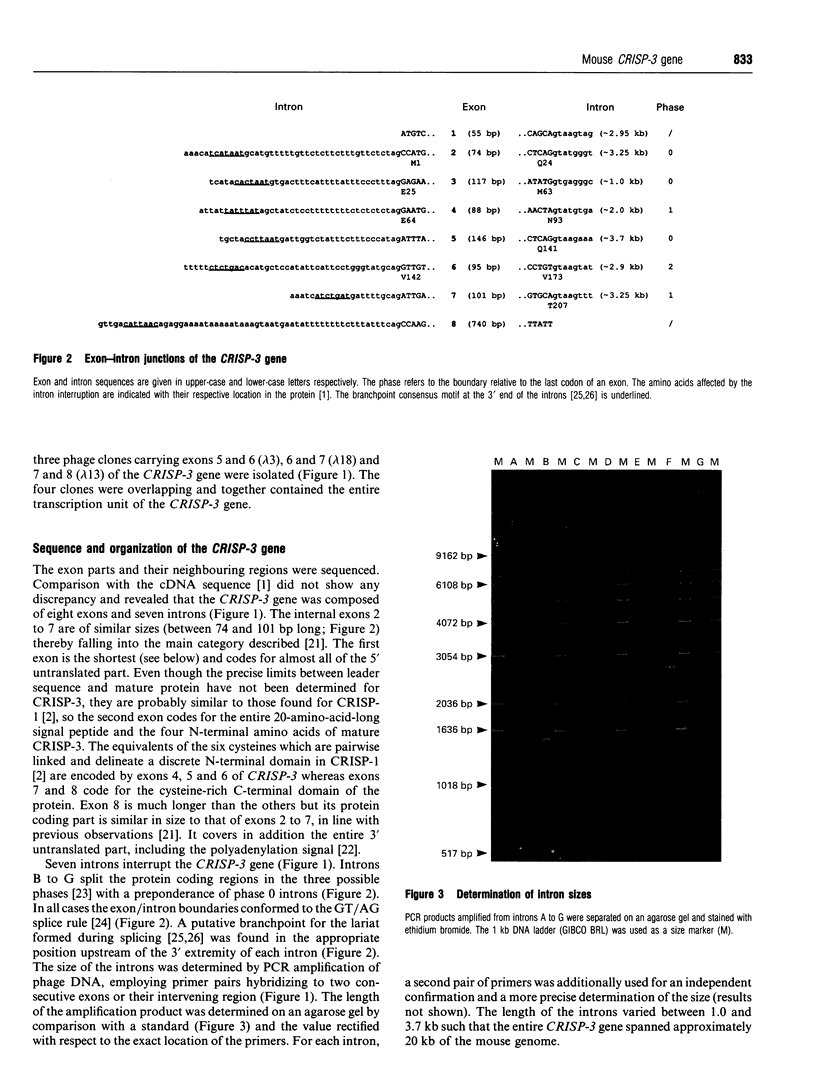
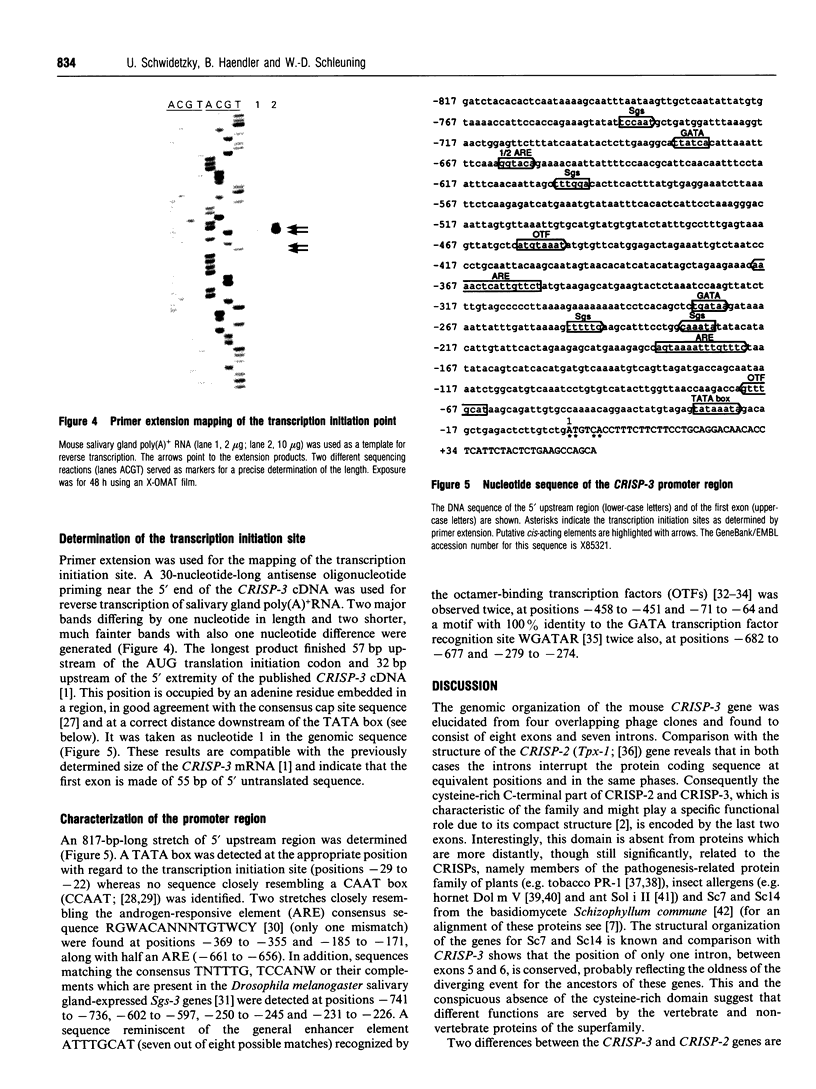
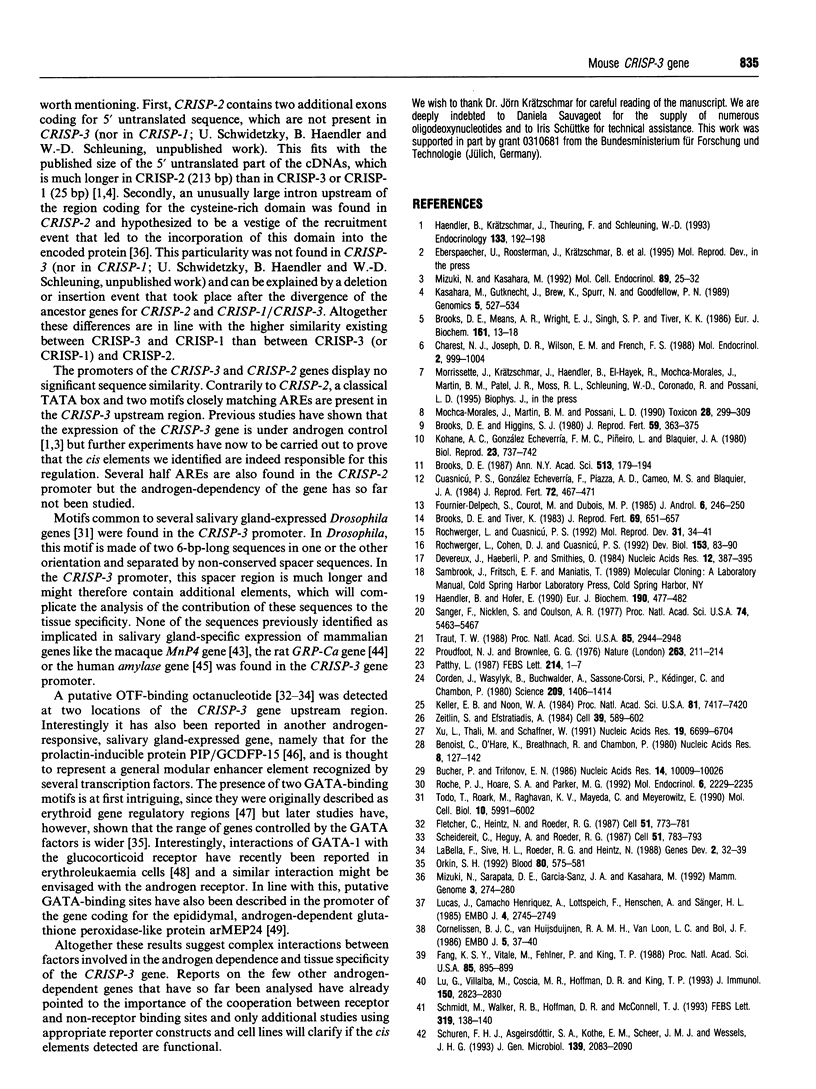
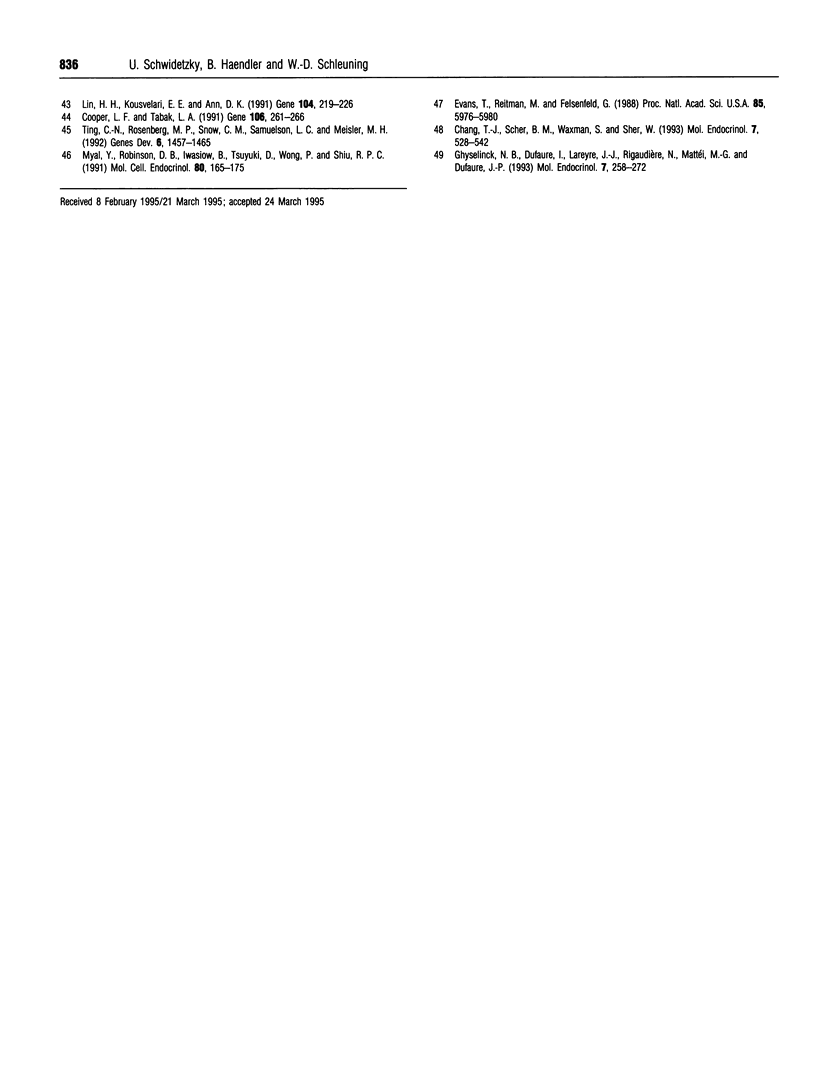
Images in this article
Selected References
These references are in PubMed. This may not be the complete list of references from this article.
- Benoist C., O'Hare K., Breathnach R., Chambon P. The ovalbumin gene-sequence of putative control regions. Nucleic Acids Res. 1980 Jan 11;8(1):127–142. doi: 10.1093/nar/8.1.127. [DOI] [PMC free article] [PubMed] [Google Scholar]
- Brooks D. E. Androgen-regulated epididymal secretory proteins associated with post-testicular sperm development. Ann N Y Acad Sci. 1987;513:179–194. doi: 10.1111/j.1749-6632.1987.tb25008.x. [DOI] [PubMed] [Google Scholar]
- Brooks D. E., Higgins S. J. Characterization and androgen-dependence of proteins associated with luminal fluid and spermatozoa in the rat epididymis. J Reprod Fertil. 1980 Jul;59(2):363–375. doi: 10.1530/jrf.0.0590363. [DOI] [PubMed] [Google Scholar]
- Brooks D. E., Means A. R., Wright E. J., Singh S. P., Tiver K. K. Molecular cloning of the cDNA for androgen-dependent sperm-coating glycoproteins secreted by the rat epididymis. Eur J Biochem. 1986 Nov 17;161(1):13–18. doi: 10.1111/j.1432-1033.1986.tb10118.x. [DOI] [PubMed] [Google Scholar]
- Brooks D. E., Tiver K. Localization of epididymal secretory proteins on rat spermatozoa. J Reprod Fertil. 1983 Nov;69(2):651–657. doi: 10.1530/jrf.0.0690651. [DOI] [PubMed] [Google Scholar]
- Bucher P., Trifonov E. N. Compilation and analysis of eukaryotic POL II promoter sequences. Nucleic Acids Res. 1986 Dec 22;14(24):10009–10026. doi: 10.1093/nar/14.24.10009. [DOI] [PMC free article] [PubMed] [Google Scholar]
- Chang T. J., Scher B. M., Waxman S., Scher W. Inhibition of mouse GATA-1 function by the glucocorticoid receptor: possible mechanism of steroid inhibition of erythroleukemia cell differentiation. Mol Endocrinol. 1993 Apr;7(4):528–542. doi: 10.1210/mend.7.4.8502237. [DOI] [PubMed] [Google Scholar]
- Charest N. J., Joseph D. R., Wilson E. M., French F. S. Molecular cloning of complementary deoxyribonucleic acid for an androgen-regulated epididymal protein: sequence homology with metalloproteins. Mol Endocrinol. 1988 Oct;2(10):999–1004. doi: 10.1210/mend-2-10-999. [DOI] [PubMed] [Google Scholar]
- Cooper L. F., Tabak L. A. Characterization of the gene encoding the salivary Gln/Glu-rich C-terminal variant A protein. Gene. 1991 Oct 15;106(2):261–266. doi: 10.1016/0378-1119(91)90208-s. [DOI] [PubMed] [Google Scholar]
- Corden J., Wasylyk B., Buchwalder A., Sassone-Corsi P., Kedinger C., Chambon P. Promoter sequences of eukaryotic protein-coding genes. Science. 1980 Sep 19;209(4463):1406–1414. doi: 10.1126/science.6251548. [DOI] [PubMed] [Google Scholar]
- Cornelissen B. J., Hooft van Huijsduijnen R. A., Van Loon L. C., Bol J. F. Molecular characterization of messenger RNAs for 'pathogenesis related' proteins la, lb and lc, induced by TMV infection of tobacco. EMBO J. 1986 Jan;5(1):37–40. doi: 10.1002/j.1460-2075.1986.tb04174.x. [DOI] [PMC free article] [PubMed] [Google Scholar]
- Cuasnicú P. S., González Echeverría F., Piazza A. D., Cameo M. S., Blaquier J. A. Antibodies against epididymal glycoproteins block fertilizing ability in rat. J Reprod Fertil. 1984 Nov;72(2):467–471. doi: 10.1530/jrf.0.0720467. [DOI] [PubMed] [Google Scholar]
- Devereux J., Haeberli P., Smithies O. A comprehensive set of sequence analysis programs for the VAX. Nucleic Acids Res. 1984 Jan 11;12(1 Pt 1):387–395. doi: 10.1093/nar/12.1part1.387. [DOI] [PMC free article] [PubMed] [Google Scholar]
- Evans T., Reitman M., Felsenfeld G. An erythrocyte-specific DNA-binding factor recognizes a regulatory sequence common to all chicken globin genes. Proc Natl Acad Sci U S A. 1988 Aug;85(16):5976–5980. doi: 10.1073/pnas.85.16.5976. [DOI] [PMC free article] [PubMed] [Google Scholar]
- Fang K. S., Vitale M., Fehlner P., King T. P. cDNA cloning and primary structure of a white-face hornet venom allergen, antigen 5. Proc Natl Acad Sci U S A. 1988 Feb;85(3):895–899. doi: 10.1073/pnas.85.3.895. [DOI] [PMC free article] [PubMed] [Google Scholar]
- Fletcher C., Heintz N., Roeder R. G. Purification and characterization of OTF-1, a transcription factor regulating cell cycle expression of a human histone H2b gene. Cell. 1987 Dec 4;51(5):773–781. doi: 10.1016/0092-8674(87)90100-0. [DOI] [PubMed] [Google Scholar]
- Fournier-Delpech S., Courot M., Dubois M. P. Decreased fertility and motility of spermatozoa from rats immunized with a prealbumin epididymal-specific glycoprotein. J Androl. 1985 Jul-Aug;6(4):246–250. doi: 10.1002/j.1939-4640.1985.tb00841.x. [DOI] [PubMed] [Google Scholar]
- Ghyselinck N. B., Dufaure I., Lareyre J. J., Rigaudière N., Mattéi M. G., Dufaure J. P. Structural organization and regulation of the gene for the androgen-dependent glutathione peroxidase-like protein specific to the mouse epididymis. Mol Endocrinol. 1993 Feb;7(2):258–272. doi: 10.1210/mend.7.2.8469239. [DOI] [PubMed] [Google Scholar]
- Haendler B., Hofer E. Characterization of the human cyclophilin gene and of related processed pseudogenes. Eur J Biochem. 1990 Jul 5;190(3):477–482. doi: 10.1111/j.1432-1033.1990.tb15598.x. [DOI] [PubMed] [Google Scholar]
- Haendler B., Krätzschmar J., Theuring F., Schleuning W. D. Transcripts for cysteine-rich secretory protein-1 (CRISP-1; DE/AEG) and the novel related CRISP-3 are expressed under androgen control in the mouse salivary gland. Endocrinology. 1993 Jul;133(1):192–198. doi: 10.1210/endo.133.1.8319566. [DOI] [PubMed] [Google Scholar]
- Kasahara M., Gutknecht J., Brew K., Spurr N., Goodfellow P. N. Cloning and mapping of a testis-specific gene with sequence similarity to a sperm-coating glycoprotein gene. Genomics. 1989 Oct;5(3):527–534. doi: 10.1016/0888-7543(89)90019-0. [DOI] [PubMed] [Google Scholar]
- Keller E. B., Noon W. A. Intron splicing: a conserved internal signal in introns of animal pre-mRNAs. Proc Natl Acad Sci U S A. 1984 Dec;81(23):7417–7420. doi: 10.1073/pnas.81.23.7417. [DOI] [PMC free article] [PubMed] [Google Scholar]
- Kohane A. C., González Echeverría F. M., Piñeiro L., Blaquier J. A. Interaction of proteins of epididymal origin with spermatozoa. Biol Reprod. 1980 Nov;23(4):737–742. doi: 10.1095/biolreprod23.4.737. [DOI] [PubMed] [Google Scholar]
- LaBella F., Sive H. L., Roeder R. G., Heintz N. Cell-cycle regulation of a human histone H2b gene is mediated by the H2b subtype-specific consensus element. Genes Dev. 1988 Jan;2(1):32–39. doi: 10.1101/gad.2.1.32. [DOI] [PubMed] [Google Scholar]
- Lin H. H., Kousvelari E. E., Ann D. K. Sequence and expression of the MnP4 gene encoding basic proline-rich protein in macaque salivary glands. Gene. 1991 Aug 15;104(2):219–226. doi: 10.1016/0378-1119(91)90253-8. [DOI] [PubMed] [Google Scholar]
- Lu G., Villalba M., Coscia M. R., Hoffman D. R., King T. P. Sequence analysis and antigenic cross-reactivity of a venom allergen, antigen 5, from hornets, wasps, and yellow jackets. J Immunol. 1993 Apr 1;150(7):2823–2830. [PubMed] [Google Scholar]
- Lucas J., Henriquez A. C., Lottspeich F., Henschen A., Sänger H. L. Amino acid sequence of the ;pathogenesis-related' leaf protein p14 from viroid-infected tomato reveals a new type of structurally unfamiliar proteins. EMBO J. 1985 Nov;4(11):2745–2749. doi: 10.1002/j.1460-2075.1985.tb03998.x. [DOI] [PMC free article] [PubMed] [Google Scholar]
- Mizuki N., Kasahara M. Mouse submandibular glands express an androgen-regulated transcript encoding an acidic epididymal glycoprotein-like molecule. Mol Cell Endocrinol. 1992 Nov;89(1-2):25–32. doi: 10.1016/0303-7207(92)90207-m. [DOI] [PubMed] [Google Scholar]
- Mizuki N., Sarapata D. E., Garcia-Sanz J. A., Kasahara M. The mouse male germ cell-specific gene Tpx-1: molecular structure, mode of expression in spermatogenesis, and sequence similarity to two non-mammalian genes. Mamm Genome. 1992;3(5):274–280. doi: 10.1007/BF00292155. [DOI] [PubMed] [Google Scholar]
- Mochca-Morales J., Martin B. M., Possani L. D. Isolation and characterization of helothermine, a novel toxin from Heloderma horridum horridum (Mexican beaded lizard) venom. Toxicon. 1990;28(3):299–309. doi: 10.1016/0041-0101(90)90065-f. [DOI] [PubMed] [Google Scholar]
- Myal Y., Robinson D. B., Iwasiow B., Tsuyuki D., Wong P., Shiu R. P. The prolactin-inducible protein (PIP/GCDFP-15) gene: cloning, structure and regulation. Mol Cell Endocrinol. 1991 Sep;80(1-3):165–175. doi: 10.1016/0303-7207(91)90153-j. [DOI] [PubMed] [Google Scholar]
- Orkin S. H. GATA-binding transcription factors in hematopoietic cells. Blood. 1992 Aug 1;80(3):575–581. [PubMed] [Google Scholar]
- Patthy L. Intron-dependent evolution: preferred types of exons and introns. FEBS Lett. 1987 Apr 6;214(1):1–7. doi: 10.1016/0014-5793(87)80002-9. [DOI] [PubMed] [Google Scholar]
- Proudfoot N. J., Brownlee G. G. 3' non-coding region sequences in eukaryotic messenger RNA. Nature. 1976 Sep 16;263(5574):211–214. doi: 10.1038/263211a0. [DOI] [PubMed] [Google Scholar]
- Roche P. J., Hoare S. A., Parker M. G. A consensus DNA-binding site for the androgen receptor. Mol Endocrinol. 1992 Dec;6(12):2229–2235. doi: 10.1210/mend.6.12.1491700. [DOI] [PubMed] [Google Scholar]
- Rochwerger L., Cohen D. J., Cuasnicú P. S. Mammalian sperm-egg fusion: the rat egg has complementary sites for a sperm protein that mediates gamete fusion. Dev Biol. 1992 Sep;153(1):83–90. doi: 10.1016/0012-1606(92)90093-v. [DOI] [PubMed] [Google Scholar]
- Rochwerger L., Cuasnicu P. S. Redistribution of a rat sperm epididymal glycoprotein after in vitro and in vivo capacitation. Mol Reprod Dev. 1992 Jan;31(1):34–41. doi: 10.1002/mrd.1080310107. [DOI] [PubMed] [Google Scholar]
- Sanger F., Nicklen S., Coulson A. R. DNA sequencing with chain-terminating inhibitors. Proc Natl Acad Sci U S A. 1977 Dec;74(12):5463–5467. doi: 10.1073/pnas.74.12.5463. [DOI] [PMC free article] [PubMed] [Google Scholar]
- Scheidereit C., Heguy A., Roeder R. G. Identification and purification of a human lymphoid-specific octamer-binding protein (OTF-2) that activates transcription of an immunoglobulin promoter in vitro. Cell. 1987 Dec 4;51(5):783–793. doi: 10.1016/0092-8674(87)90101-2. [DOI] [PubMed] [Google Scholar]
- Schmidt M., Walker R. B., Hoffman D. R., McConnell T. J. Nucleotide sequence of cDNA encoding the fire ant venom protein Sol i II. FEBS Lett. 1993 Mar 15;319(1-2):138–140. doi: 10.1016/0014-5793(93)80053-w. [DOI] [PubMed] [Google Scholar]
- Ting C. N., Rosenberg M. P., Snow C. M., Samuelson L. C., Meisler M. H. Endogenous retroviral sequences are required for tissue-specific expression of a human salivary amylase gene. Genes Dev. 1992 Aug;6(8):1457–1465. doi: 10.1101/gad.6.8.1457. [DOI] [PubMed] [Google Scholar]
- Todo T., Roark M., Raghavan K. V., Mayeda C., Meyerowitz E. Fine-structure mutational analysis of a stage- and tissue-specific promoter element of the Drosophila glue gene Sgs-3. Mol Cell Biol. 1990 Nov;10(11):5991–6002. doi: 10.1128/mcb.10.11.5991. [DOI] [PMC free article] [PubMed] [Google Scholar]
- Traut T. W. Do exons code for structural or functional units in proteins? Proc Natl Acad Sci U S A. 1988 May;85(9):2944–2948. doi: 10.1073/pnas.85.9.2944. [DOI] [PMC free article] [PubMed] [Google Scholar]
- Xu L. C., Thali M., Schaffner W. Upstream box/TATA box order is the major determinant of the direction of transcription. Nucleic Acids Res. 1991 Dec 25;19(24):6699–6704. doi: 10.1093/nar/19.24.6699. [DOI] [PMC free article] [PubMed] [Google Scholar]
- Zeitlin S., Efstratiadis A. In vivo splicing products of the rabbit beta-globin pre-mRNA. Cell. 1984 Dec;39(3 Pt 2):589–602. doi: 10.1016/0092-8674(84)90466-5. [DOI] [PubMed] [Google Scholar]





